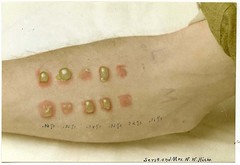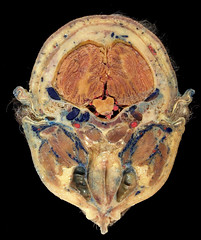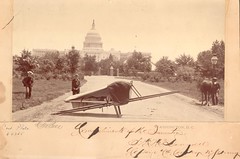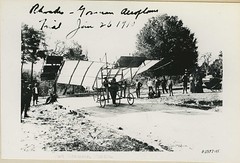Archives intern Sara Gonzales has written a finding aid for the recent donation of a scrapbook owned by AFIP director Raymond Dart.
An unofficial blog about the National Museum of Health and Medicine (nee the Army Medical Museum) in Silver Spring, MD. Visit for news about the museum, new projects, musing on the history of medicine and neat pictures.
Friday, February 11, 2011
Dart Scrapbook finding aid now online
Sunday, October 3, 2010
Pictures of average Civil War soldiers

SCDV 192 Ulmur, David, CO. M 4th PA Cavalry, battle of Dinwiddie Court House
The Washington Post is reporting an excellent donation of 700 pictures of average Civil War soldiers to the Library of Congress.
Va. collector donates Civil War photographs to Library of Congress
By Michael E. Ruane
Washington Post Staff Writer
Saturday, October 2, 2010
The Medical Museum of course took or collected thousands of these types of pictures during the war, excepting the showing of a wound, of course. You can see some on our Flickr site. We also have a donated album - Pleasants Photograph Album (1865) - that we scanned and put online recently. Here's the description of it:
Photograph album of Frances Pleasants, who taught wounded soldiers at the Army Hospital in Germantown, PA during the Civil War. Presented to her by her patients, it contains photographs of them as well as other Civil War images. Includes albumen cartes-de-visite, tintypes, and newspaper clippings. Note: where image numbers are missing in the sequence, those places in the album are empty and the pages were not digitized.
Friday, July 9, 2010
Letter of the Day: July 9
Louisville, Ky., July 9 1863
General,
I have the honor to enclose four photographs for the “Cripple’s Gallery”, Army Med. Museum,
+ to remain,
Very Res’lly
Yr Obdt Svt.
J. F. Head,
Surg’n. U.S.A.
Brigr. Gen. W. A. Hammond,
Surg. General
U.S.A.
Washington D.C.
Wednesday, April 14, 2010
Letter and Photographs of the Day: April 13 addition
Curatorial Records: Numbered Correspondence 8202
April 13, 1905
Mr. J. E. Standley,
Colman Dock,
Seattle, Washington
Sir:
Your letter of the 4th inst. Addressed to the Smithsonian Institution, containing two photographs of Samoans showing elephantiasis and one of a Javanese woman with multiple fibrous tumors has been referred with the photographs to the Surgeon General, U.S. Army, for deposit in the Army Medical Museum.
The Surgeon General directs me to express his thanks to you for the photographs and to inform you that they will be added to the series of contributed photographs of this Museum.
Very respectfully,
C.L. Heizmann
Col. Asst. Surgeon General, U.S.A.
In charge of Museum & Library Division
These two pictures from Ye Old Curiosity Shop and Indian Curio of Colman Dock, Seattle, became CP 2593 and 2594.

Thursday, March 18, 2010
Letter of the Day: March 18
Boston
89 Charles St
March 18 ‘72
My Dear Dr.
I sent to you some months ago, by Express, a box containing a cast of the face of Charles XII, a cast of a large stone that was cut out from the peritoneal cavity & two or three small ones. As I have not heard of their arrival, I am afraid that some accident may have happened to them & will be ruined. Obliged to you if you will let me know if they have been received.
I send, enclosed, a photographer of a Hottentot Venus, that I think will be interesting in your ethnographical Section, which you probably have. It is possible that I have sent you one before, tho I think not.
A few days ago, rec’d for our College Museum the photograph of a little girl 5 yrs old, who has been menstruating regularly since she was 15 months old. Her breasts, which are shown, are larger than those of other women. I do not wish any [illegible] of persons or places to be referred to, but, if you would like to have a copy, I think that you might get one by addressing Dr. Wm. Dickinson, 520 Locust St, St. Louis (Missouri I presume).
Yours very truly
J.B.S. Jackson
George A. Otis, Surgeon
U.S.A.
Monday, March 15, 2010
Another Archives collection scanned
Here's an example:

Saturday, October 24, 2009
Latest Flickr statistics
This mustard gas testing shot has been popular lately:

We're working on a project to get many 700,000 images we currently have scanned online for searching and use (although as many as 50,000 of those are book pages we've already loaded onto Internet Archive). Stay tuned for more details.
Wednesday, April 29, 2009
NLM updates its photo website
New look, advanced features for NLM's Images from the History of Medicine (IHM)
The History of Medicine Division of the National Library of Medicine announces the launch of a new image platform for its premier database, Images from the History of Medicine (IHM). Using award winning software developed by Luna Imaging, Inc., NLM offers greatly enhanced searching and viewing capabilities to image researchers. Patrons can view search results in a multi-image display, download high resolution copies of their favorite images, zoom in on image details, move images into a patron-defined workspace for further manipulation, and create mediagroups for presenting images and sharing them via e-mail or posting on blogs. With these new capabilities, NLM greatly enhances usability of its image collection, where inspection and comparison of images is often as important as access to bibliographic data. IHM is available online, free of charge, at http://ihm.nlm.nih.gov.
Comprising almost 70,000 images from the Prints and Photographs and other collections held in the History of Medicine Division, IHM is one of the largest image databases in the world dedicated to images of medicine, dentistry, public health, the health professions, and health institutions. The collection includes portraits, photographs, caricatures, genre scenes, posters, and graphic art illustrating the social and historical aspects of medicine. Most types of printmaking are represented: woodcuts, engravings, etchings, mezzotints, aquatints, and lithographs. Also included in the collection are illustrations from the
historical book collection. Newly acquired posters and other materials are continually being added to IHM. The collection is administered by the NLM History of Medicine Division.
Located in Bethesda, Maryland, the National Library of Medicine is the world's largest library of the health sciences. For more information, visit the Web site at http://www.nlm.nih.gov/.
The National Institutes of Health (NIH) -- The Nation's Medical Research
Agency -- includes 27 Institutes and Centers and is a component of the
U. S. Department of Health and Human Services. It is the primary federal
agency for conducting and supporting basic, clinical, and translational
medical research, and it investigates the causes, treatments, and cures
for both common and rare diseases. For more information about NIH and
its programs, visit http://www.nih.gov/.
Ginny Cathcart
Curator, Prints and Photographs
History of Medicine Division
National Library of Medicine
For questions, please contact the History of Medicine Division Reference
Desk at hmdref@nlm.nih.gov
Thursday, April 23, 2009
New book of dissection photographs by Jim Edmondson
Monday, April 6, 2009
What would it take to make a Civil War veteran happy?
Here's a post-Civil War letter from veteran Alexander Rider to Dr. Reed Bontecou talking about the difficulties of having a photograph made when he can't leave the house, and asking for an accordion. From the Museum's accession records for SS 2030. Click on the photo to see it larger for reading. Rider was a Private, Company I, 76 Pennsylvania Volunteers, wounded at Pocotaligo, SC on October 22, 1862.




Monday, March 23, 2009
Anatomical Collections adds photos to Flickr

Brian of our Anatomical Collections department is putting some cool photos up on Flickr too.
Since we passed 500,000 viewers late last night, we've gone up to 628,026 now. You like us, you really like us (that's a quote of sorts). If you've found us from somewhere besides Wired, Boing Boing, NPR or Austria's public television, chime in and let us know, please.
Wednesday, March 18, 2009
Wired article drives visitors to Flickr site
Some people have been asking about HIPAA, which provides for privacy of medical records. These photographs were taken for medical education by various sources including the Army Medical Museum's Museum & Medical Arts Service (MAMAS) photographers which had no role in treating patients (or an electronic billing relationship with them which is the main criteria for applying HIPAA), but was sent out to theaters of war to take pictures. Additionally, when we created the scanning database, we did not capture the name of the patient. We have tried to be very careful about selecting images that are anonymous UNLESS the photograph was previously published with the names included (as all the Civil War and Signal Corps pictures were). The whole secure scanning database of over 500,000 images, which is not available to the general public, has many restricted images that only administrators can see. We'll continue to make a subset of them available somehow, but keep in mind that with over 2500 boxes of photographs - it's going to take a long time and there's a lot of junk.
These photographs have been available to the public as part of the AFIP's Medical Illustration Service Library since the 1940s - this is just the first time that they have been easily viewable without visiting Washington, DC. The other half of the old Army Medical Museum & Library's collection was put online years ago by the National Library of Medicine (which has a far larger budget than we do) - http://wwwihm.nlm.nih.gov/cgi-bin/gw_44_3/chameleon?skin=nlm&lng=en
Another excellent source is the Wellcome's photo library, which like ours, includes clinical images of diseases (which the Library of Medicine does not).
Finally about that 'permission' thing in the Wired article - what we're waiting on is permission to join Flickr Commons, which asked us last year and has certain legal requirements, not permission to post public domain photographs online. We can ask our web manager to post them on our own website - Flickr just has far more viewers and we could do it ourself in seconds once upon a time.
Anyone interested in the history of the medical museum and photographs may want to read this article.
Tuesday, March 17, 2009
Wired discovers the Museum's online photographs
I think I come off as a bit strident there, but we are creating a massive new resource and need to make it available in new ways. Most of these photographs were never described in any database (although there is a set of index cards that fills a wall) and we're discovering and seeing them for the first time too. There are so many pictures that no one of us is seeing all of them - the contractor's scanning team working on this has 7 people just getting the pictures catalogued to be scanned. And there's at least 2000 boxes left to go.
Remember that these photos are in the public domain so you can repurpose them for your own use - let us know if you come up with something particularly interesting.
By the way, at 10 pm, we're at 64,787 views for the Flickr account (formerly Otis Archives1) that Kathleen paid for and then collapsed all 4 pre-existing accounts into (and the old Otis Archives 2 has 32,778; 3 has 23,897; and 4 half-full with only 104 pictures has 2,206). That's 123,668 views since we started on September 22 2006.
(By 10:23, we're up to 65,505 views on the main account - enjoy!)
Monday, January 19, 2009
Sharing historical photographs
Link by Link
Historical Photos in Web Archives Gain Vivid New Lives
By NOAM COHEN
Published: January 19, 2009
Over the last year there have been important new efforts to put these classics online.
Tuesday, December 9, 2008
Museum souvenir DIY
Here’s how you do it.
Go to one of the four “Otisarchives” flickr sites as linked to on the right side of the blog. Look through the photos and select the one you like. There's roughly 700 photographs in the 4 accounts.
Click on it and then on the top of the photo, click on ‘all sizes’. Select ‘download’ for the large size which will save it to your harddrive.
For Zazzle, where I’ve been experimenting, go to http://www.zazzle.com and establish an account. Click on ‘create a product’ and pick a product. Click on ‘add an image’ and then pull the picture off your harddrive. Position it on the product until you like it. You can add multiple images or text to some products. You can also make multiple products using the same image which will have been stored in your account under ‘my images.’
Click on either ‘add to my cart’ or ‘post for sale’ when you’re happy with the way it looks.
Pay them and do what you will with the finished product. They can be a bit cranky when it comes to publishing stamps and wouldn’t let my Civil War surgery experiment go out to the world, although they sold me the stamps.
Have fun. Let me know if you do anything particularly interesting.
Wednesday, December 3, 2008
A couple of pictures
Monday, November 24, 2008
Blackhawk as sickbed reading, circa 1951

Here's a picture that one of the assistant archivists brought to my attention today. This poor guy has a gunshot wound of his lower femur (shown with a Blackhawk comic book on the bed) during the Korean War, 1951.
Scanned on a computer old enough to require a scuzzy port to connect to the scanner, copied to a cd and then carried home to be uploaded to Flickr and blogged about.
Thursday, November 20, 2008
Photos aren't us
Here's the policy as sent out by Walter Reed's Department of Information Management (DOIM):
Effective immediately, the use of USB storage devices are suspended on all DoD NIPRNET and SIPRNET computers.
This rule will be technically implemented beginning 19 1800 November 2008 and will be applied across the entire network on all computers. Implementation of this rule will impact all memory sticks, thumb drives, USB external hard drives, and camera flash memory cards. USB connected printers with internal and external media storage (e.g. SD Cards, etc.) may also be impacted.
Other USB connected devices such as keyboards, mice, CAC readers, and blackberries "SHOULD NOT" be affected. Any user that experiences problems with such devices after technical implementation is asked to call the DOIM help desk or follow the procedures noted below for faster service.
These actions are being completed as part of an Army-Wide Information Assurance initiative to protect the DOD network from intrusion and continuous attacks. In order to further protect our network we ask all users to adhere to posted rules and allow us the opportunity to find secure alternatives (if those exists) to meet mission needs.
Wednesday, November 19, 2008
Today's discoveries
Today I worked on a reference request that included anything we have on the Polish Relief Commission in World War 1. Searching for images for someone else is almost like spending someone else's money. I have all the fun and it's on someone else's dime. Cool.
We have about 100 pictures that include the Commission's name in the caption. Some of them, like some of just about everything, are, sorry, boring, but some just grab you right off and demand a second look.
Here's what I mean.

Reeve 31754 Polish Relief Commission (Col. Gilchrist). Little Polish girl.

Reeve 31756 Polish Relief Commission (Col. Gilchrist), opening public bathing place, distribution of cigarettes.

Reeve 31765 Polish Relief Commission (Col. Gilchrist), three waifs, fatherless & motherless, from effects of typhus fever, near Dora-Husk, Poland, 1920.

Reeve 31770 Polish Relief Commission (Col. Gilchrist), delousing Bolsheviks on the highways, 1919-1920.

Reeve 31933 Polish Relief Commission. (Col. Gilchrist). American equipment in the near east. Foden Thresh steam sterilizer with A.P.R.E. to Poland.

Reeve 31935 Polish Relief Commission (Col. Gilchrist). Cases of cholera left by retreating Bolsheviks near Villna, 1919.
Now admit it. Don't I have a great job?


